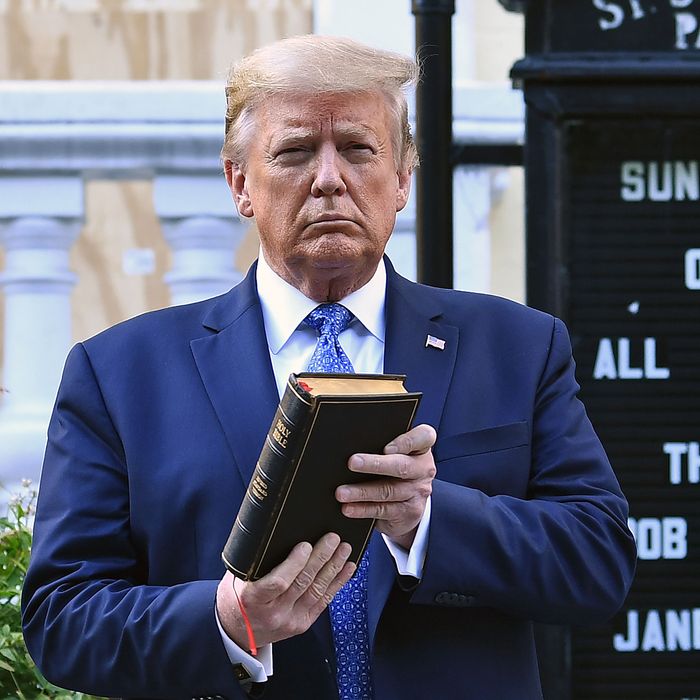RENDER UNTO TRUMP
White Evangelicals Made a Deal With the Devil. Now What?
By Sarah Jones

In the end, white Christian America stood by its man. The exit polls present an imperfect but definitive picture. At least three-quarters of white Evangelicals voted for Donald Trump in November, a figure largely unchanged from 2016. Evangelicals didn’t win Trump another four years in power, but not for lack of effort. While most of America tired of the president’s impieties, the born-again found in themselves a higher tolerance for sin.
And the sins are legion, lest we forget. He tear-gassed protesters so he could walk to a D.C. church and hold a Bible upside-down in front of it without interference. He lied and cheated, and smeared women who accused him of sexual assault. He separated migrant children from their parents and staffed his administration with white nationalists. Over a quarter of a million Americans died of the coronavirus, while he railed against doctors and scientists trying to save lives. Not even a plague turned Evangelicals from their earthly lord. For Trump, the consequences are political and legal. For Evangelicals, the fallout has a more spiritual quality. What does it profit a faith to gain a whole country and then lose it, along with its own soul?
Evangelicals had more to lose than Republicans, for reasons I learned in church as a child. You can’t evangelize anyone if your testimony is poor. If you disobey your parents, or wear a skirt that falls above your knees, how can anyone believe you’re saved? Another Sunday school lesson, conveniently forgotten? Be sure that your sin will find you out. Evangelicals bought power, and the bill is coming due. The price is their Christian witness, the credibility of their redemption by God. Evangelicalism won’t disappear after Trump, but its alliance with an unpopular and brutal president could alienate all but the most zealous.
To be Evangelical in the 1990s was to learn fear. The world was so dangerous, and our status in it so fragile. The fossil record was a lie, and scientists knew it. You could not watch the Teletubbies because Jerry Falwell thought the purple one was gay. No Disney, either, and not because Walt had been a fascist; Disneyworld allowed a gay-pride day, and in one scene of The Lion King, you could see the stars spell out “sex.” You were lucky to even be alive, to have escaped the abortion mill. The predominantly white Evangelical world in which I was raised had created its own shadow universe, a buffer between it and the hostile world. Our parents could put us in Christian schools or homeschool us; if they did risk public school, we could take shelter with groups like YoungLife and the Fellowship of Christian Athletes, which would tell us to make the most of this chance to save souls. We had alternatives for everything; our own pop music, our own kids’ shows, our own versions of biology and U.S. history, and an ecosystem of colleges and universities to train us up in the way we should go: toward the Republican Party, and away from the left, with no equivocation.
Whatever the cause, whatever the rumor, the fear was always the same. It was about power, and what would happen if we lost it. Certain facts, like the whiteness of our congregations and the maleness of our pulpits and the shortcomings of our leaders, were not worth mentioning. You were fighting for God, and God was not racist or sexist; He was only true. The unsaved hated this, it made them angry, and that was proof you were doing the right thing. If “owning the libs” has a discernible origin point, it’s here, in the white Evangelical church.
While I was in college and Trump was still a reality-show star, Evangelicals faced a crisis in the pews. Young people were leaving the church, and they weren’t coming back. The first signs arrived in 2007, in the last hopeful months before the Great Recession. A pair of Christian researchers released a study with troubling implications for the future of the church. Young people aged 16 to 29 were skeptical of Christianity and of Evangelicalism in particular, concluded Dave Kinnaman of the Barna Group and Gabe Lyons of the Fermi Project. “Half of young churchgoers said they perceive Christianity to be judgmental, hypocritical, and too political,” they wrote. Among the unchurched, attitudes were even more negative. A mere 3 percent said they had positive views of Evangelicalism, a precipitous decline from previous generations.
I interviewed Lyons about his research while I was a student journalist at Cedarville University, a conservative Baptist school in Ohio. By the time I graduated, I’d become one of his statistics, an atheist with a minor in Bible. Trump was not even a glimmer in Steve Bannon’s eye, but the Evangelical tradition had already asked me to tolerate many sins. There was George W. Bush and his catastrophic invasion of Iraq; welfare policies that starved the poor; the dehumanization of immigrants, of LGBT people, of women who do not wish to stay pregnant, and my own, non-negotiable submission to men. At some point I realized that I had traveled some distance in my mind, and I could not go back the way I came. I was over it, I was through.
The years after my personal exodus brought with them more proof that the church was in trouble. Partisanship did not entirely explain why. Membership declined fastest in mainline congregations, even though they tend to be more liberal than the independent churches of my youth. Social media has expanded the philosophical marketplace; all Christian traditions face competition from new ideologies for the hearts and minds of the young. But conservative denominations are suffering, too. The Southern Baptist Convention said this June it had experienced its 13th consecutive year of membership decline. By age 22, two-thirds of adults who attend Protestant services as teenagers have dropped out of church for at least a year, LifeWay Research found last year, and a quarter cited political disagreements as the reason. An alliance with a president the young largely hated might not lure new generations to the fold.
Years of attrition have taken a toll on white Evangelicals, said Robert Jones, the author of The End of White Christian America and the founder of the Public Religion Research Institute. “If you go back a couple of election cycles ago, into Barack Obama’s first election, they were 21 percent of the population, and today they are 15 percent of the population,” he told me. The share of Black Evangelicals has remained relatively stable, he added, while the numbers of Latino Evangelicals has grown. And while these groups ostensibly share a religious label, politically they are far apart.
“If I take the religious landscape, and I sort religious groups by their support for one candidate or the other, what inevitably happens is that there are no two groups further away from each other in that sorting than white Evangelical Protestants and African-American Protestants,” Jones said, adding that Latino Evangelicals are “a little more divided.” (Indeed, Trump won significant support from this group in 2020.)

But white Evangelicals are still outliers overall: They’re more conservative than other Protestants, more conservative than Catholics, more conservative, in fact, than any other demographic in the country. The implicit claim of the Moral Majority — that it embodied mainstream opinion — always lacked evidence, but it’s become even less true over time. By the time Trump applied Richard Nixon’s label of a “silent majority” to his own coalition, it barely made sense at all. A bloc that can only take the White House through the Electoral College, and not the popular vote, only to lose it outright four years later, has no claim to majority status. They are a remnant within a remnant, a nation within a nation.
There are still dissenters. Last year, the outgoing editor of Christianity Today, Mark Galli, called for Trump’s removal from office. Galli wrote the typical approach for his magazine was to “stay above the fray,” and “allow Christians with different political convictions to make their arguments in the public square, to encourage all to pursue justice according to their convictions and treat their political opposition as charitably as possible,” he wrote. But Trump had abused the power of his office and revealed a “grossly deficient moral character.” Galli has since converted to Catholicism, a decision he explained to Religion News Services as being more personal than political.
Others stay. But they can experience a painful friction between their spiritual convictions and political independence. My parents, both pro-life Evangelicals, have now voted against Trump twice. I spoke to another by Skype, not long before the election.
I know Marlena Proper Graves from my days at that Baptist university, when I was an upstart college feminist, and she was a resident director and the spouse of a professor. Now the author of two books on faith and a doctoral candidate at Bowling Green State University, Graves worries about the influence of Trump, and Trump’s party, on her beloved church. The word “Evangelical,” she noted, had always referred to a constellation of beliefs. “You have a relationship with God, God cares about you, God cares about all people, and Christ is central,” she said, ticking them off. “But now it seems to be something of a culture.” That culture is an exclusionary one. “I’ve been disinvited from events because of my views and activism for immigrants, because it’s controversial,” she said.
When Proper was young, she told me, she listened to Christian radio all the time, just like I did. Preachers and commentators like James Dobson, a famed radio personality and the founder of Focus on the Family, would opine on the issues of the day, on morality, and virtue. “All these people would talk about character,” she said. “How you can’t vote for Bill Clinton in particular because of Monica Lewinsky, because he had affairs.” Then came Trump. “People said, first, that they didn’t think he would win. Then it was all about abortion and judges. I felt like I was being punked,” she remembered. But many Evangelicals are in on the joke. Faced with popular rejection and the humiliation of Trump, they declare themselves persecuted, and identify numerous enemies. The mission remains the same: Purify the nation, and pacify the barbarians.
Beyond the usual celebrity-preacher scandals, the faith’s place in the broader Christian right required it to make moral compromises it never tolerated among the rank-and-file members of the flock. Our definition of morality narrowed the further up the pyramid you climbed. For the politicians we backed, it shrank to a pinprick point: Ronald Reagan was divorced. What mattered instead to the Moral Majority was his opposition to abortion, his hippie-bashing, his ability to trade in euphemisms about “states’ rights.” Two Bush presidents later, thrice-married Trump gave Evangelicals the conservative Supreme Court of their dreams.
As hypocritical as white Evangelical support for Trump may look from the outside, the president actually understood his base quite well. Eight years of a Black, liberal president threatened their hegemony. So had the Supreme Court’s ruling legalizing same-sex marriage. Sarah Posner, an investigative journalist and the author of Unholy: Why White Evangelicals Worship at the Altar of Donald Trump, told me that Trump managed to tap into two key Evangelical tendencies. “Those two things were the racial grievances of the white base of the Republican Party, and how televangelism had changed Evangelicalism from the 1970s onward,” she said.
Galli, the former Christianity Today editor, believes Trump also appealed to an entrenched Evangelical sense of marginalization. By the time same-sex marriage was legalized, public opinion on LGBT rights had already liberalized; the gap between white Evangelicals, and everyone else, on matters of sexuality is now wider than it’s ever been. “Here comes Donald Trump, saying it’s okay to be Christian, it’s okay to have your values, it’s okay to practice your values in the public square. And he does this in a very authoritative manner,” Galli explained. Trump didn’t know his Scripture, but he knew there was a war on, and that was enough. The nation’s culture warriors had found their general.
Evangelicals, Galli added, “are deeply suspicious of human authority,” but only to a point. What they may fear, really, is authority they don’t control. “Paradoxically,” he continued, “they are a group that’s attracted to authoritarian leaders, whether that person be a pastor of a megachurch or a dictator.” Those tendencies existed before Trump. With the help of the far-right press, social media, and alternative institutions, they will survive Trump, too.
“I think that the thing that we have to keep our eye on is the ways in which the infrastructure that they built gives them an advantage beyond what their numbers would tell you,” Posner said. Conservative Evangelicals already know that they’re no longer the Moral Majority, and they’ve found a way to make it work for them. “They’ll recognize, for example, that they may be in the minority on LGBTQ rights, but in their view, that’s all the more reason that they should be protected by either the Religious Freedom Restoration Act, or the First Amendment, in having the right to discriminate against LGBTQ people.”
That infrastructure still churns out new acolytes, who embrace the worst elements of the tradition we all used to share. The same movement that produced me also spawned Madison Cawthorn, a Republican elected to Congress last month. He was born the year the Southern Baptist Convention first apologized for slavery, and he will be the youngest member of Congress when he takes office in January. He’ll also be one of furthest-right Republicans in office, with a personal life that once again tests the bounds of Evangelical toleration for sin. Women from his Christian homeschooling community in North Carolina and women who studied with him at the conservative Patrick Henry College have accused him repeatedly of sexual harassment and misconduct. A racist website linked to his campaign criticized a local journalist for leaving academia to “work for nonwhite males” like Senator Cory Booker, “who aims to ruin white males.” After he won, he celebrated with a tweet. “Cry more, lib,” he wrote.
There’s time for Cawthorn to self-immolate on a pyre of his own sins before he’s old enough to run for president. But there will be other Cawthorns, other white Evangelical candidates who will try to master Trumpism-without-Trump. They might not need an army to win, either. The GOP already knows it doesn’t have to be popular to stay in power. They need a radical remnant, and a lot of dirty tricks. Republicans can get what they want by suppressing the vote, or by undermining our confidence in elections. They can protect themselves through the subtle tyranny of inequality, which empowers the wealthy while alienating the most under-represented among us. A party out of step with most voters must either reform, or it must cheat. This, too, is something the modern GOP has in common with the Christian right. Democracy is the enemy. People can’t be trusted with their own souls. Leave them to their own devices, and they make the wrong choices, take the easy way out, threaten everything holy. They need a savior, whether they like it or not.
White Evangelicals Made a Deal With Trump. Now What? (nymag.com)











